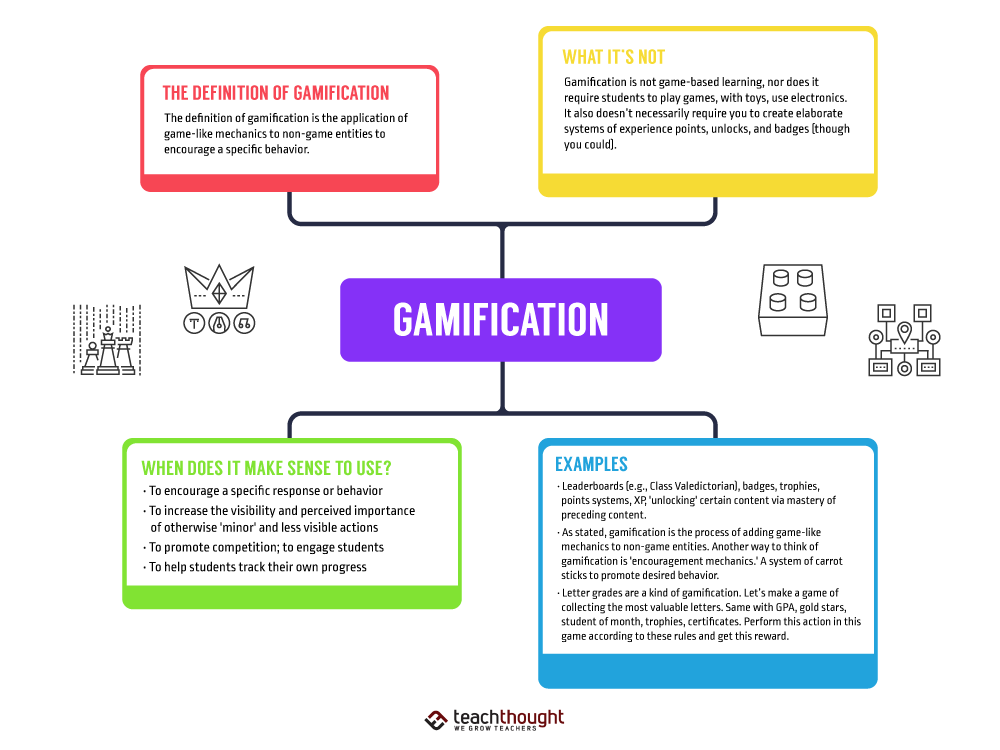
What Is The Difference Between Gamification And Game-Based Learning?
Gamification and game-based learning are each buzzwords (and buzzphrases) in education. Each can offer your classroom something, but many mistake one for the other.
Can you tell the difference?
The Definition Of Gamification
The definition of gamification is the application of game-like mechanics to non-game entities to encourage a specific behavior.
What It’s Not
Gamification is not game-based learning, nor does it require students to play games, with toys, use electronics. It also doesn’t necessarily require you to create elaborate systems of experience points, unlocks, and badges (though you could).
When Does It Make Sense To Use?
- To encourage a specific response or behavior
- To increase the visibility and perceived importance of otherwise ‘minor’ and less visible actions
- To promote competition; to engage students
- To help students track their own progress
Examples
Leaderboards (e.g., Class Valedictorian), badges, trophies, points systems, XP, ‘unlocking’ certain content via mastery of preceding content.
As stated, gamification is the process of adding game-like mechanics to non-game entities. Another way to think of gamification is ‘encouragement mechanics.’ A system of carrot sticks to promote desired behavior.
Letter grades are a kind of gamification. Let’s make a game of collecting the most valuable letters. Same with GPA, gold stars, student of month, trophies, certificates. Perform this action in this game according to these rules and get this reward.
In How Gamification Uncovers Nuance In The Learning Process, Terry Heick wrote that “life is itself ‘gamified’—loosely, through informal social competition (‘keeping up with the Joneses’), to the buzz extreme couponers get comparing receipts, to comparing 401k portfolios, gaining access to ‘Platinum’ or ‘Black’ credit cards, or collecting frequent flyer miles. Even sticking a push-pin into the map of every traveling destination you’ve ever visited is a form of ‘gamification.’ As are Boy Scout Badges. You’re making a game out of something that isn’t.”
The Definition Of Game-Based Learning
The definition of game-based learning is simply learning through games.
What It’s Not
Obsessing over video games, nor does it absolutely require you or students to play the games (though ideally, you would); it also doesn’t require video games—that would be video game-based learning. It is simply the use of the inherent design of most games (more on that below) to learn.
Learn what? That depends—could be simply becoming better at the game, but in most educational settings, students will instead learning academic and non-academic content by playing games.
When Should You Use Gamification?
This is likely another post–or entire course–of its own but a few ideas and rules for using gamification in the classroom?
1. To differentiate or personalize instruction
2. To motivate students–whether previously disengaged or already excelling
3. Promote critical and strategic thinking
4. To support both struggling and talented students
5. To clarify learning progress for other stakeholders–parents, for example
6. To improve the potential of existing learning models like project-based learning or blended learning
Among the ideal uses of game-based learning is learning simulations. Historical simulations like Civilization V are powerful learning tools, as they allow students to sit with, analyze, interaction with, and otherwise struggle with complexity.
They force players to play the rules of the game’s universe (or they are designed to let the players create their own rules). This requires students to understand complex ideas—resource management, political tactics, diplomacy, communication, etc. Unlike a traditional lesson or activity, in game-based learning, unless the student refuses to play they have to learn the rules, and then respond to a constantly changing world.
Games of any kind—whether serious games like Civilization V, Assassin’s Creed, simulations like ‘The Universe Sandbox’–encourage practice, competition, self-direction, scaffolding, collaboration, trial-and-error persistence, patience, strategic thinking, self-efficacy (for some), and a variety of other important possibilities.
The Difference Between Gamification and Game-Based Learning
So what’s the difference?
Gamification is first and foremost about encouragement mechanics and the system that promotes them, while game-based learning is first and foremost about the game and its cognitive residue (whether from the game’s content, or academic content). One can use the other.
They both can lead to content mastery, but neither are expressly designed for classroom use—which is why, done well, your students will probably like them.
The Benefits Of Gamification: student engagement and motivation, can encourage creative and complex thinking, resource management, prioritization, and other critical thinking skills; transparency of a wider number of skills and competencies versus traditional teaching and grading models, target specific competencies or skills, emphasize intrinsic motivation (versus extrinsic), possibility of improved socialization
The Difference Between Gamification And Game-Based Learning